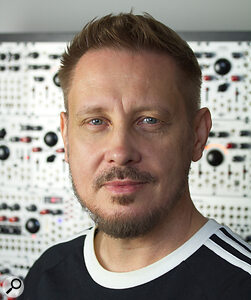 XAOC Devices (pronounced ‘chaos devices’ if you happen to be reading this to your kids) are without a doubt one of Eurorack’s most respected developers, with a host of functional and beautiful modules to their name. One of the central figures behind that success is Maciek Bartkowiak, a veritable heavyweight in electronic instrument design and a charming fellow to boot.
XAOC Devices (pronounced ‘chaos devices’ if you happen to be reading this to your kids) are without a doubt one of Eurorack’s most respected developers, with a host of functional and beautiful modules to their name. One of the central figures behind that success is Maciek Bartkowiak, a veritable heavyweight in electronic instrument design and a charming fellow to boot.
On his entry into modular
I first encountered synthesizers through a TV show at the age of 13, and that moment sparked a lifelong obsession. Even before formally studying electronics, I began collecting magazine articles about them. At 18, I built my first polyphonic synth, and by 21 I had designed a hybrid digital/analogue sampler. I went on to study electronics and telecommunications and earned a PhD in Signal Processing.
Over more than two decades in academia, I contributed to the MPEG Audio standard and now hold several DSP‑related patents. All this provided a solid background to what I do today. For a long time, modular synthesizers struck me as outdated and unnecessary — why break down subtractive synthesis into separate, cumbersome blocks? That view changed completely when I met XAOC. I realised that modular is not about following the book on synthesis, but about rewriting it.
I realised that modular is not about following the book on synthesis, but about rewriting it.
On his circuit design philosophy
Above all, I value innovation and have little interest in copying classic designs. I’m proud of the many small inventions embedded in our circuits, even if they remain invisible to the user. My colleagues often set ambitious standards for new modules, and meeting them can be a significant challenge. It usually requires multiple prototype iterations and careful refinement, but the result is always deeply rewarding.
I enjoy working with upper‑shelf modern components — even when they might seem excessive — because they bring a sense of elegance, long‑term reliability, and subtle sonic advantages that some users genuinely appreciate. That said, I also occasionally draw on simple, old‑school circuit techniques that introduce intentional imperfections — essential in shaping what has become the XAOC signature sound.
On the story of XAOC Devices
Designing and building synthesizers for a living had been my dream since the early days, but for a long time there were no synthesizer companies in Poland. That changed in 2012 when Marcin and Tomek founded one with the release of the Moskwa sequencer. I first heard about them through our mutual friend Michał and thought, how many of those could they possibly sell — 50? Then I discovered the rapidly growing Eurorack scene and realised the scale of what was happening.
We eventually met, and Marcin invited me to join. At first, I was hesitant to leave my academic career, but once I took the leap, everything accelerated. From the start, the focus was on ambitious projects. Praga, our mixer, took five years to develop — but it was worth every moment. Odessa was another demanding endeavour, developed in collaboration with my colleague Adam who is a specialist in FPGA design. XAOC began as a team of three. We now have 12 people on board — and I believe that’s the right size.
On the XAOC Lublin
In the Lublin VCA module, the Ping input is often seen as its standout feature — but to me, it’s just the cherry on top. The project was initially motivated by the success of Tallin, our first VCA, which was intentionally designed to be imperfect, nonlinear, and sonically coloured. Lublin was conceived as a counterpoint to that: a clean, transparent VCA built around a 2180‑type Blackmer gain cell.
Still, basic VCA functionality can feel somewhat uninspiring, even though it’s essential in every system. The pinging feature gave Lublin a unique character. I modelled its nonlinear time response using a network of diodes, based on how real vactrols behave in various classic modules. The result captures that initial bell‑like curve, a transition phase, and a long, natural‑sounding tail reminiscent of reverb. It was a first step into vactrol modelling, a kind of trial run, and I hope it will lead to a fully featured LPG‑style module in the future.
Machine learning will gradually make its way into modular synthesis as well, enabling highly complex, ‘intelligent’ behaviours that may further reduce the need for patching creativity.
On the future of modular synthesis
I believe that modular synthesis as a method has not yet reached its full potential — but I worry that its popularity may wane before it gets there. As the format becomes more mainstream, it becomes increasingly influenced by short‑term trends and fleeting fads, which shape demands for new modules. It’s easy to foresee a rise in digital modules that encapsulate specific combinations of building blocks, offering instant access to compelling sounds with minimal effort. Machine learning will gradually make its way into modular synthesis as well, enabling highly complex, ‘intelligent’ behaviours that may further reduce the need for patching creativity.
Personally, I remain passionate about analogue design and still hope to see the development of more advanced analogue ICs from manufacturers like Alfa RPAR and SSI. Such components could enable the creation of sophisticated yet affordable devices. A filter bank on a chip, an oscillator array, or a precision arbitrary function generator would be true game-changers.
